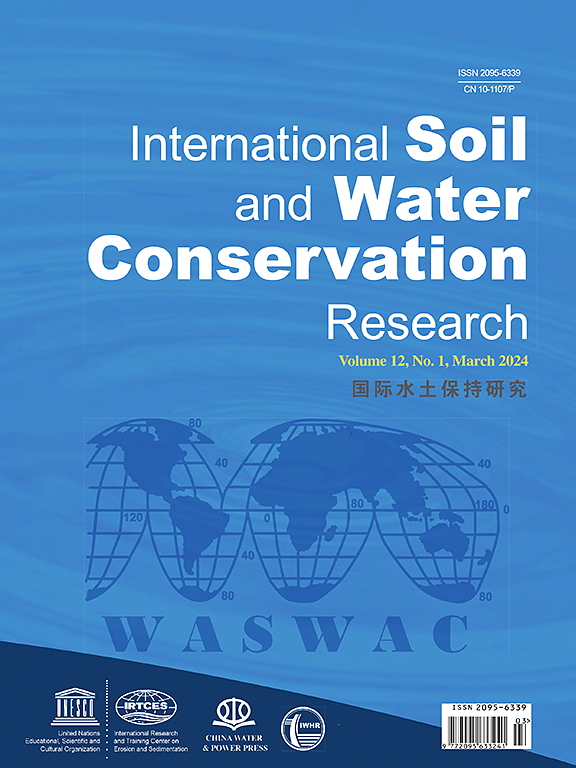Soil erosion elasticity initiative for prioritizing sub-watersheds
IF 7.3
1区 农林科学
Q1 ENVIRONMENTAL SCIENCES
International Soil and Water Conservation Research
Pub Date : 2024-12-11
DOI:10.1016/j.iswcr.2024.12.001
引用次数: 0
Abstract
Quantitative evaluation of soil erosion is necessary to analyze the destructive effects of soil erosion and to identify priority sub-watersheds in different climatic and environmental conditions. The variability of soil erosion thresholds introduced as Erosion elasticity (Ee) can be used to develop reliable management strategies in various temporal and spatial scales. Ee is a potential degree of soil erosion in an area representing the magnitude between maximum and minimum erosion rates. However, the comprehensive prioritization of sub-watersheds according to environmental changes and the concept of Ee is yet to be done. Therefore, the present study introduced the Ee-based approach based on the watershed's maximum and minimum soil erosion capability. The prioritization of the sub-watersheds of the Shazand Watershed of Iran has been exemplified, and the associated results were compared to those of conventional annual soil erosion zoning. Towards that, the mean annual soil erosion and corresponding changes of the study watershed were estimated according to the dynamic changes of vegetation cover and rainfall erosivity. Prioritizing 24-study sub-watersheds was then comparatively conducted using mean annual soil erosion and erosion elasticity approaches. The results of the RUSLE application showed that the soil erosion of the Shazand Watershed varied between 0 and 72 t ha−1 year−1 with a mean annual erosion of 14.35 t ha−1 year−1. The results further revealed that the worst and the best combination of soil erosion factors cause +151% and −62% changes in mean annual soil erosion of the Shazand Watershed. Based on the amount of soil erosion method, sub-watersheds 11, 14, and 23 were placed in the highest priorities, and sub-watersheds 5, 6, 16, and 17 are the lowest priority for management measures. In addition, the results of the Ee approach showed that 28% of the study sub-watersheds were placed in high and relatively high priorities, respectively, and sub-watersheds 9, 13, 18, 19, and 23 stand in the lowest priority. The Ee approach effectively identified the critical sub-watersheds to reduce their tendency to destructive conditions and take appropriate measures to reduce their soil erosion and move them towards ideal conditions. The results can help planners and managers implement the best management measures in priority sub-watersheds, saving time and cost.

优先分流域土壤侵蚀弹性倡议
定量评价土壤侵蚀是分析土壤侵蚀破坏性效应和确定不同气候环境条件下优先分流域的必要条件。土壤侵蚀阈值的变异性被称为侵蚀弹性(Ee),可用于制定在不同时空尺度上可靠的管理策略。Ee是一个地区潜在的土壤侵蚀程度,表示最大和最小侵蚀率之间的幅度。然而,根据环境变化和Ee概念对流域进行综合优先排序的工作尚未完成。因此,本研究引入了基于流域最大和最小土壤侵蚀能力的e-based方法。举例说明了伊朗沙赞德流域分流域的优先次序,并将相关结果与常规年度土壤侵蚀区划的结果进行了比较。为此,根据植被覆盖度和降雨侵蚀力的动态变化,估算研究流域年平均土壤侵蚀量及其变化。采用年平均土壤侵蚀和侵蚀弹性方法对24个研究子流域进行了优选比较。RUSLE应用结果表明,沙滩流域土壤侵蚀在0 ~ 72 tha−1年−1之间变化,年平均侵蚀量为14.35 tha−1年−1。土壤侵蚀因子最差和最佳组合对沙滩流域年平均土壤侵蚀的影响分别为+151%和- 62%。根据水土流失量法,第11、14、23个子流域的治理措施优先级最高,第5、6、16、17个子流域的治理措施优先级最低。此外,Ee方法的研究结果表明,28%的研究子流域分别被评为高优先级和较高优先级,而第9、13、18、19和23子流域被评为最低优先级。Ee方法有效地识别了关键流域,以减少其破坏性条件的倾向,并采取适当措施减少其土壤侵蚀,使其朝着理想条件发展。研究结果可以帮助规划者和管理者在重点子流域实施最佳管理措施,节省时间和成本。
本文章由计算机程序翻译,如有差异,请以英文原文为准。
求助全文
约1分钟内获得全文
求助全文
来源期刊

International Soil and Water Conservation Research
Agricultural and Biological Sciences-Agronomy and Crop Science
CiteScore
12.00
自引率
3.10%
发文量
171
审稿时长
49 days
期刊介绍:
The International Soil and Water Conservation Research (ISWCR), the official journal of World Association of Soil and Water Conservation (WASWAC) http://www.waswac.org, is a multidisciplinary journal of soil and water conservation research, practice, policy, and perspectives. It aims to disseminate new knowledge and promote the practice of soil and water conservation.
The scope of International Soil and Water Conservation Research includes research, strategies, and technologies for prediction, prevention, and protection of soil and water resources. It deals with identification, characterization, and modeling; dynamic monitoring and evaluation; assessment and management of conservation practice and creation and implementation of quality standards.
Examples of appropriate topical areas include (but are not limited to):
• Conservation models, tools, and technologies
• Conservation agricultural
• Soil health resources, indicators, assessment, and management
• Land degradation
• Sustainable development
• Soil erosion and its control
• Soil erosion processes
• Water resources assessment and management
• Watershed management
• Soil erosion models
• Literature review on topics related soil and water conservation research
 求助内容:
求助内容: 应助结果提醒方式:
应助结果提醒方式:


